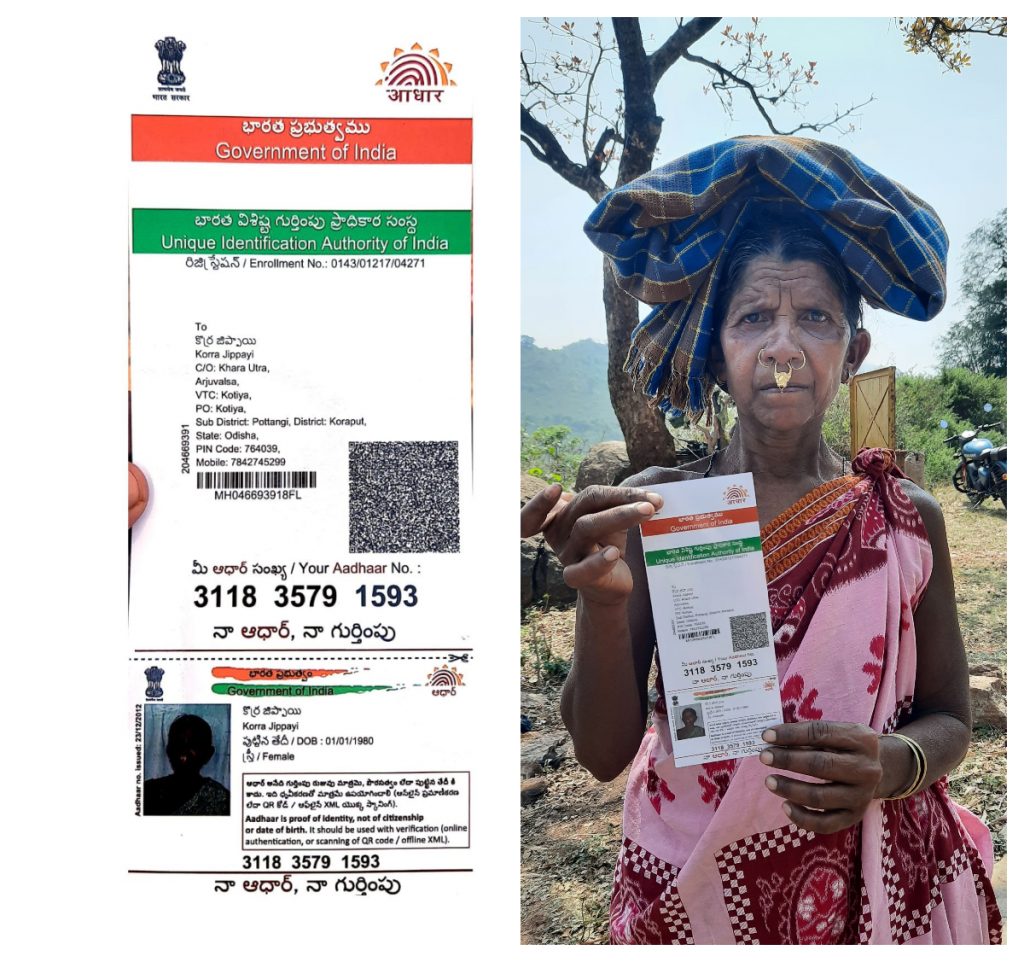Pottangi/Nandapur: Though the state government has been emphasising on the protection of Odia language in border villages, alarming deviations have been observed. A recent incident in Koraput district’s Kotia region, a bone of contention between Odisha and neighbouring Andhra Pradesh, has raised concerns about the state of Odia language in the border areas. During the Odisha Day celebrations in Pottangi block Tuesday, an elderly woman’s Aadhaar card was found to contain various details written in Telugu instead of Odia.
The woman was identified as Khara Jhipai, 70, of Arjubalsa village in Kotia panchayat. The discovery has raised questions as to why an Odisha-issued Aadhaar card would prioritise Telugu over the state’s official language. Additionally, the woman’s date of birth on the card was found to be incorrect. Though she is approximately 70 years old, her Aadhaar card lists her age as 45. Such errors have led to many border residents being deprived of Odisha government benefits under various welfare schemes, while neighbouring Andhra Pradesh has reportedly taken advantage of the situation. The issue highlights concerns over the protection of Odia language in border areas. When asked why she had brought her Aadhaar card to the event, the elderly woman stated that she had been instructed to do so after being denied an old-age pension.
She also confirmed that she was not receiving any pension benefits. When contacted, Sudhir Sahu, Block Social Security Officer (BSSO) of the Persons with Disabilities (PwD) department in Pottangi, stated that the elderly individual’s Aadhaar card does not appear online. However, he noted that many marginalised villagers in the concerned panchayat have reportedly edited their Aadhaar details to claim benefits from two different states, which could lead to complications and risks for them. Block Development Officer (BDO) Ramakrusna Nayak acknowledged the issue, stating it had come to his notice.
He further said that he informed the district administration about the matter. “Discussions are underway to resolve Aadhaar-related discrepancies independently and bring them to the attention of the Union government,” he added.
Meanwhile, residents of Nandapur, Lamtaput, Pottangi, Bandhugaon, and Narayanpatana blocks of Koraput are gradually shifting from Odia to Telugu as their primary language. While indigenous communities such as the Kui, Paraja, Bhumia, Bhatra, and Gadaba tribes still converse in their native dialects, educational institutions in the region continue to follow an Odia-language curriculum.
Residents in Panthlung, Bilaput, Golur, Paraja Badapada, Kularsing, Chatua, Khinbara, and Nandaka panchayats depend heavily on Andhra for trade, healthcare, education, and livelihood. This economic reliance has contributed to a linguistic shift, with many residents choosing to speak and write in Telugu, distancing themselves from Odia.
Telugu over Odia Language experts and educationists warn that this trend could threaten the future of Odia in the region. Intellectuals have urged the government to take necessary measures to protect the language. Sources said eight panchayats in Nandapur block, having 70 per cent population from Kui, Paraja and Gadaba tribes, are located near the Andhra Pradesh border. They receive their education in Odia language from schools established in these villages by the state government.
However, the residents cross the border and travel to weekly markets in Andhra Pradesh to sell their agricultural produce and purchase essential goods. They also rely on Andhra for weddings, education, and healthcare services. While there, they often use Telugu instead of Odia, both in conversation and writing, sometimes opting for English as well. When contacted, Nandapur Block Development Officer Durga Prasad Dora and Block Education Officer Bhabani Nandan Pattnaik said the state’s Culture and Education departments are aware of the issue. With support from block and district administrations, various initiatives have been launched to safeguard Odia language. As part of these efforts, the district education department has appointed 364 multilingual education (MLE) teachers specialising in languages of Kui, Paraja, Gadaba, Bhumia, and Bhatra tribes. Around 53 Paraja-language teachers are currently engaged in Nandapur block alone, Pattnaik stated.
